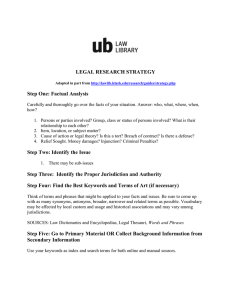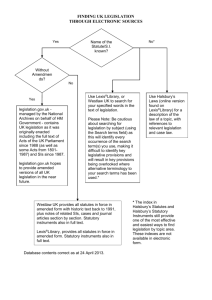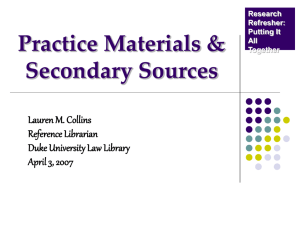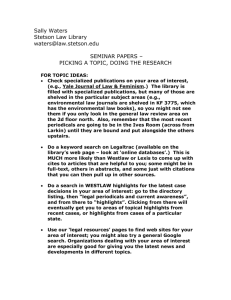Legal Research Outline – First Semester 11/1/2007 10:11:00 AM
advertisement
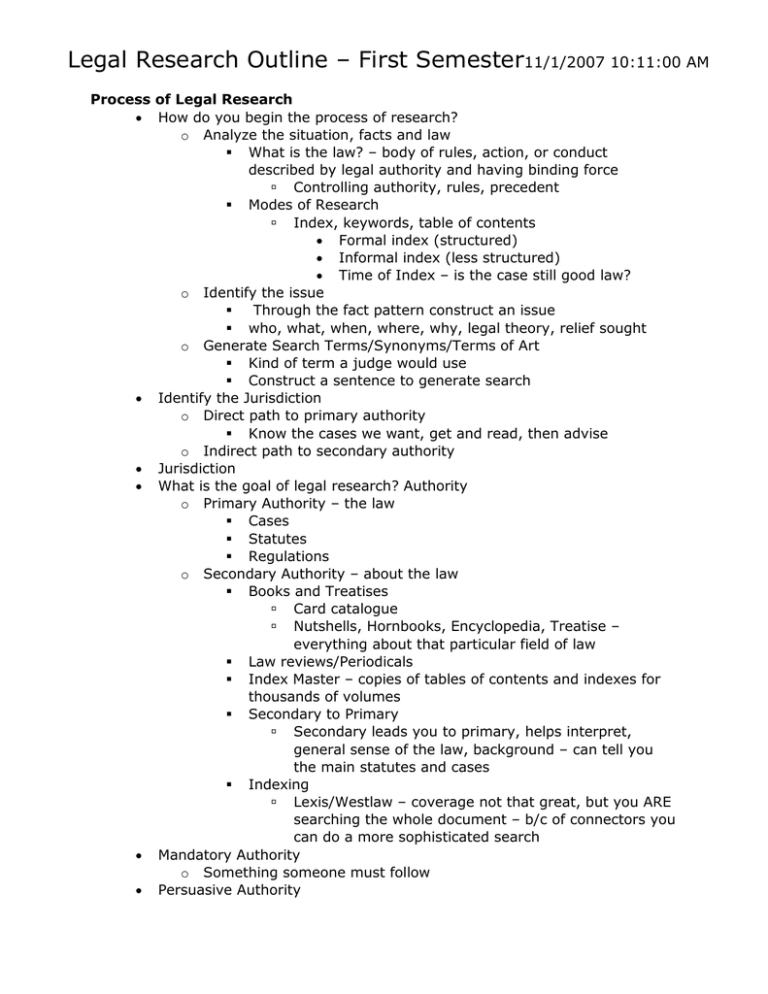
Legal Research Outline – First Semester11/1/2007 10:11:00 AM Process of Legal Research How do you begin the process of research? o Analyze the situation, facts and law What is the law? – body of rules, action, or conduct described by legal authority and having binding force Controlling authority, rules, precedent Modes of Research Index, keywords, table of contents Formal index (structured) Informal index (less structured) Time of Index – is the case still good law? o Identify the issue Through the fact pattern construct an issue who, what, when, where, why, legal theory, relief sought o Generate Search Terms/Synonyms/Terms of Art Kind of term a judge would use Construct a sentence to generate search Identify the Jurisdiction o Direct path to primary authority Know the cases we want, get and read, then advise o Indirect path to secondary authority Jurisdiction What is the goal of legal research? Authority o Primary Authority – the law Cases Statutes Regulations o Secondary Authority – about the law Books and Treatises Card catalogue Nutshells, Hornbooks, Encyclopedia, Treatise – everything about that particular field of law Law reviews/Periodicals Index Master – copies of tables of contents and indexes for thousands of volumes Secondary to Primary Secondary leads you to primary, helps interpret, general sense of the law, background – can tell you the main statutes and cases Indexing Lexis/Westlaw – coverage not that great, but you ARE searching the whole document – b/c of connectors you can do a more sophisticated search Mandatory Authority o Something someone must follow Persuasive Authority o Something someone may or may not follow Case Law & Digests Judiciary o Lower courts bound by higher courts’ decisions o Appellate Court – orders and opinions o Trial Courts – verdicts, rulings, occasionally an opinion o Documents Generated by Judiciary – generally the opinions Slip Opinion 1st form of court rendered opinion Advance Sheet 2nd form – paperback – chronological arrangement, as reported – not by subject – takes about two months to get out, and privately produced – West’s Reporter 3rd Form – bound – arranged chronologically – depends on your jurisdiction o How are the judiciary documents published? Slip opinion, advance sheet, bound reporter Official Reporter o Produced by the government Unofficial Reporter o Produced by private publisher, usually West o Divided country into different regions Sometimes you have both official and unofficial o Parallel Cites: same case in official and unofficial – case cited in both Digest and Reporter Published vs. Unpublished Opinions o Unpublished – decisions not designated for publication by the courts – many available through electronic research and on the Internet Non-precedential o Published – those opinions designated by the courts for publication Precedential Citing Opinions Elements of Reported Decision o Name of Case o Docket Number o Court o Date of Decision o Summary o Disposition of Case o Headnotes – brief summaries of a point of law – arranged numerically – summary of legal issue West divides all law into 7 broad categories, and then subtopics West creates table of contents for the field of law – subdivides topics and assigns keynumbers Digests o Index to cases – arranged alphabetically by the topics o Used to find authority o 7 broad headings – 400 topics arranged alphabetically o Scope – telling you what’s contained in a particular subject o Getting into Digest Index by subject Descriptive Word Index 4-5 volumes at beginning/end of set – give you the name of topic and keynumber – goal is to get to BLURBS – address of the case first number: volume; abbreviation: reporter; then page number Table of Cases – cases by name – alphabetically by the name of both the plaintiff and the defendant Defendant/plaintiff index (by name of defendant) Table of words and prhases – a judge has written definitions o By Jurisdiction Look in bluebook – jurisdiction, the area where the opinion comes from Jurisdiction Digests are organized by jurisdiction and date Four jurisdictional categories: federal, state, regional, combined o Topic Outlines Contain the topic, summary, subjects excluded and covered by other topics, and key numbers, outline of subtopics covered by each key number Topic – 400 subcategories west divides digest into Key number – each subdivision category is assigned a key number – the case summaries within a West digest will appear under the relevant key number – allow you to focus more specifically on the precise issue you’re researching o Digest Paragraphs Blurbs about cases giving summary of the law in the case o Update Pocket part – “closing table” tells you what it covers Mini-digest in the back of the volume Cover the volume, pocket part, pamphlet that covers the entire set, volume by volume, and the advance sheets o American Digest – all states and federal – rarely used Treatises o Explores particular doctrine in depth o o o o o o Purpose – clarify, extensive footnotes, great detail on subject, cited by courts Bound volumes – updated with pocket parts or supplements Loose-leaf – updated by inter-filling Library catalogue Index master Alphabetical index organized by topic Citators “Cited” vs. “Citing” references o Citing – cases which cite TO your case o Cited – your case Stare Decisis o The doctrine of precedent, under which a court must follow earlier judicial decisions when the same points arise again in litigation Ratio Decidendi o The principle or rule of law on which a court’s decision is founded o The rule of law on which a later court thinks that a previous court founded its decision; a general rule without which a case must have been decided otherwise Direct History o Subsequent history of the case o Same case on appeal, same parties, facts, and legislation Indirect History o How other courts outside of the direct line have treated your case – commenting on, explaining your case o Encyclopedias, treatment, law reviews, attorney general’s opinions Why use a Citator? o Allows you to discover the subsequent history of the case – what happened after the case was decided o If the case has gone to the next level, how it was treated, if overruled o Use to update – still valid law – make sure not reversed or overruled – research tool o Find law reviews, text or treatises, ALR, etc. o 1. Direct History, 2. Indirect History Lexis/Westlaw o Signal indicators – status of your case, treatment of your case Red – BAD Yellow – not so bad, not good Can’t rely on the indicators – state can stand for more than one proposition – must read the case to tell o Locate Features – focus/limit your search – restrict your search, jurisdiction, headnotes o Table of Authorities Treatment of cases cited – lists the documents cited by your case – shows you whether or not those cases have negative history or not Lexis Uses symbols, like red stop sign, yellow triangle Shepard’s – used to be a paper one, but most libraries don’t subscribe o Westlaw Westlaw uses flags to show the treatment of the case. Treatment stars – how much the case is talked about in the citing case (four green stars, they talked about it a lot) o Citating a Case They do not show legislation affecting that case unless other legislation points to that effect o Citating a Statute Online cite to statutes of effect – when you citate the statute, they don’t’ indicate that there is a negative act of the legislature If there’s a positive act, you’ll see it in the citator ALR – American Law Report What are ALRs? o Reports selective cases o Not authority, not necessarily scholarly – good overview, survey, identify leading cases, identify other sources o Began in early 1900’s – printed leading cases, then started adding annotations Location in Library o Annotations on 2nd floor o Online catalogue Authors of Annotations o Written by lawyers hired by publisher Case Coverage o Timely and/or controversial opinions o Covers a leading case, ties to summarize related cases, review how issue is settled in different jurisdictions Annotation Coverage (typical) o Collect summaries of cases from a variety of jurisdictions to provide an overview of the law on a topic o More detailed than encyclopedias o References to other research sources Annotation Uses o Like an article – survey a legal issue, well-researched – tell how different jurisdictions treated the issue Persuasive Authority Organization of Series o ALR 1st, 2nd, 3rd, 4th, 5th o o ALR Fed – Federal Issues Elements of ALR o Usually begins with a case 1. Reprint the case 2. Table of contents for the article 3. Total client service (citing to other things they have published) 4. Annotation Index 5. Jurisdictional table (what jurisdictions have been cited, where in the article) Available Indexes o General index – printed in multiple volumes o ALR Digest – not too useful o Tables (depending on the index) o ALR Quick Index – very useful – multi-volume index in smaller type – one big book They have one for the Fed as well o Index Organization Quick index – covers 3rd, 4th, 5th – does not cover first and second Topical index, may have numerical – one that’s like a digest How ALR’s are Updated o Volume o Pocket part o Sometimes they are written, sometimes an older annotation is superceded o Supplement – pocket part Proper Citation Format o Elements Restatements Publisher o Organization called American Law Institute Purpose o Clear restatement of the Common Law o Codification of common law – the MAJORITY view – some emerging trends, what they think the rule should be o Most citable of secondary sources – most courts regard highly Individual Restatement Organization o Restatement 1st, 2nd, 3rd – because there is a Restatement 3rd, does not mean there is a first – numbers refer to WHEN published 20-40’s: Restatement 1st 50-80’s: Restatement 2nd 90-Present: Restatement 3rd Individual Section Information o The rule where they’re trying to restate the common law – various editorial enhance Appendix volume which reports the cases – you’ll see some reported in the first volume of the rule, after that it’s part of the appendix o Elements Rule where they restate the common law Comments Illustrations Reporter’s notes Case summaries Do Restatements refer to specific statutes? o No Illustrations – actual cases? o No Individual Restatement Updates Editorial Enhancements o Illustrations, comments, text of rule itself, annotations Location in the Library o Behind reserve desk Other Access o Online access to Westlaw and Lexis o Card Catalogue – keyword search Primary Law? o No – secondary Restatement Indexes o Each volume indexed individually o Index is cumulative – sometimes you have to check each volume, sometimes you don’t o No overall index ALI Activities o Restatements, some model acts, professional organization Proposed/Tentative Restatement Drafts o Published during the course of working on and revising the volume o See trends, where the law is headed Encyclopedias Terms of art, background information o Index: articles arranged alphabetically, index that covers articles in the book, tables in the front, pocket part (the update) o American Jurisprudence 2nd More references to statutes than CJS On Westlaw and Lexis – need to be aware of how current it is Topics in alphabetical order – more attention to federal statutes than CJS – so summary at beginning of section – extensive footnotes to primary material – general index, new development volume – no comprehensive summary of state rules o National coverage o Corpus Juris Secundum Oriented toward common law – complete restatement of the entire American law as developed by all reported cases Restates body of American law as derived from reported cases and legislation Classify and articulate legal doctrines, not explain legal system Topic and sections in alphabetical order Detailed table of contents Reference to large number of cases – almost no statutes Brief summary of legal principles Over reliance on case law Updating – cumulative annual pocket parts National coverage o 17 State Encyclopedias – citations to primary law, leading cases, and relevant statutes Comprehensive – by subject Coverage – specific state o Editorial Enhancements Publishers want you to use their stuff References to other things they published that would be on point Pocket part keeps volume current What are the access points o Table of contents o Subject index o Tables Articles Footnotes Copyright date Updating procedure Periodicals Wilson Web Index to Legal Periodicals (1980- current) o Coverage – the index to legal periodicals o Online version Current Law Index o Started in 1980 o Coverage o Legal Trac – what CLI paper version is now called Coverage – covers more newspapers, puts more up in PDF Index to Legal Periodicals o Began in late 1800’s – followed classification at that time o Coverage – index of periodicals – before 1980 Heinonline.org – web version of old paper versions – database contains periodicals - alphabetical, by volume, by page, PDF format o Jstore – periodicals online, download in pdf Law/Bar Journals o Law: scholarly specialized; written by law professors o Bar: not scholarly, very practical; by attorneys for attorneys Accessing Legal Periodicals o Online Information needed to locate an article o Volume, the name of the periodical, and the page o Periodical – subject terms if you don’t know the volume, name, and page Two Online Computer Services o Advantages of using the search engines Difference – coverage – Legal Trac covers more newspapers, and it’s faster o Differences between the two search engines Coverage Location of most recent edition of a legal periodical in the library o What happens when all the unbound issues of a volume are received? o They are bound Location of bound periodicals in the library o 5th Floor, North – recent periodicals o Other locations of old periodicals in the library Hein online, microfiche, behind circulation desk Why would a lawyer read a state or regional legal newspaper? o Article, new case, some news – notice 2 Legal Periodicals that cover Illinois courts? o Index to legal Periodicals, Legal Trac Legal Magazine on specific topic are – how helpful? Legal Newsletter – how useful? o Specializing in a particular area of law – current in the field Persuasive authority Online Library Catalogue Key Words Subject Title Author Author/Title Public Law Number Library of Congress Call Number Government Document Number Temporary Reserve by Course Name or Activity Temporary Reserve by Professor/TA o LC Call Numbers World Cat – huge database – collective catalogue – collective resources of 25,000 libraries Statutes Chronological Arrangement o Slip Laws – first publication of statutes – pamphlet with text of 1 legislative act o Session Laws – slip laws bound chronologically o Code Code/Subject Arrangement o Subject index – General index Revised Code o Code set out in titles based on subject matter o Statute without editorial enhancements o Publish supplements in the off years Annotated Code o Revised code with editorial enhancements – written by 3rd party o Arrangement of laws by subject o Popular names, words and phrases, cross references o Historical and Statutory notes – when first passed, subsequent amendments o Library references o Notes of decisions o Westlaw Keynumbers – cite to CJS Statute Indexes o List of statutes, library references, history Tables o Popular Name Tables – statutes have names, this is an index that lists the statutes by their names How Statutes are Updated o Bound Volume o Pocket Part o 2 Pamphlets – one will update decisions, one will update statutes o Useful Websites – state legislature, Google, city websites o Lexis, Westlaw Annotations o Interim annotation service Statute o Perfected – version of bill finally passed by house or senate o Enrolled – version sent to executive – will be the law, provided they don’t make any changes This is the copy you want to get Citation o Title, name of set, section number, year Computer Assisted Research Boolean Logic Terms o Root expander - ! – variations of end of word o Universal character - * - variations of letter – dr*nk o Connectors And Not – westlaw, type “but not” or “%” – lexis, type “and not” Or – westlaw, type “or” or leave a space – lexis, type “or” Numerical proximity /n Grammatical /s /p Miscellaneous o Plurals – use singular form if you can o Possessives – use singular form o Hyphens – in westlaw, can’t hurt – lexis, use both forms o Numbers o Phrase searching Lexis defaults to phrases Westlaw you have to use quotes Order of processing o () o Or o Numerical Proximitty Connectors (smallest to largest) o Grammatical Connectors (/s before /p) o And o Not Westlaw/Lexis o Search temrs o Structure of a database Record Database Segments/fields o Connectors Westlaw assumes “or” Lexis assumes “and” Lexis assumes phrase searching o Segment/Field restrictions Westlas (fields) lexis (segments) Examples: court, topic, headnote, judge, attorney, docket # Adds precision Unrestricted search – words found anywhere in document o Accessing the Resources Authority Cost Efficiency Ease of use Is one source enough? No Citing Volume, name of source, page o 765 F. 2d 342 ALR citing – bluebook o Author’s name, title
